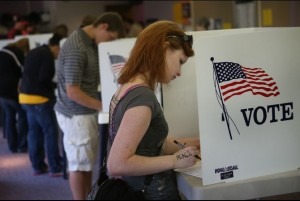In 2008, about half (48.5 %) of Americans age 18 to 24 turned out to vote. Two years later, only 21.3 percent showed up (Source, US Census 2008, 2010).
“Dropoff Voters”—citizens who vote in Presidential elections but then fail to turn out for another four years—represent about half of young voters. Specifically, 18- to 24-year-olds cast 12.5 million votes in 2008, a record high. Two years later, the number of votes cast by that same group (then aged 20 to 26) dropped by 47 percent, to about 6.5 million (Source, US Census, 2008, 2010).
The dropoff voter phenomenon means that a measurably older group of Americans will pick every member of the House of Representatives, one third the Senate and 36 governors—all up for election on November 4th this year.
Control of the House has changed hands in both the last two midterms and three of the last five. The Senate has also flipped in three of the last five Midterm Elections.
But check this out: in a survey earlier this year, only 23 percent of young Americans said they definitely planned to vote in November, down from 31 percent in a similar survey just five months before! (Source: Harvard Institute of Politics)
The gap is growing over time. Back in 2002, the dropoff among voters was virtually the same for most age groups—a dip of 17.5 percentage points for voters under 30 and an almost identical 17 point drop for voters 30+. Jump ahead just four years to 2006, and the dropoff for under 30 voters was 23.5 percentage points, but only 14 points for those over 30. Young voters dropped off in an even higher proportion in 2010, when there was a 27 point decline in turnout by voters under 30, compared to just 16 percent for the rest of the electorate (Source: CIRCLE).
Interestingly, educated young people are the most likely to be dropoff voters. Turnout by 18- to 24-year-olds with bachelors degrees was 71% in 2008 and just 33% in 2010. The 38% gap in turnout is the highest for any cohort (source: US Census, 2008, 2010).
Voter turnout will unquestionably impact the issues people care about most. In 2013 alone, 22 states passed laws relating to abortion. Since 2003, 23 states have either legalized or banned same-sex marriage. Since 1996, 22 states have legalized medical marijuana.
Twenty-two states have also passed laws restricting access to voting itself. We live in a time where the average Latino voter has to wait in line 50% longer than whites to vote, and African-Americans wait twice as long. Rather than correcting this problem, some elected officials are erecting new barriers to democratic participation.
If we do nothing, a very small percentage of Americans will have all the power. So join HeadCount as we gear up for the Midterm Elections.
